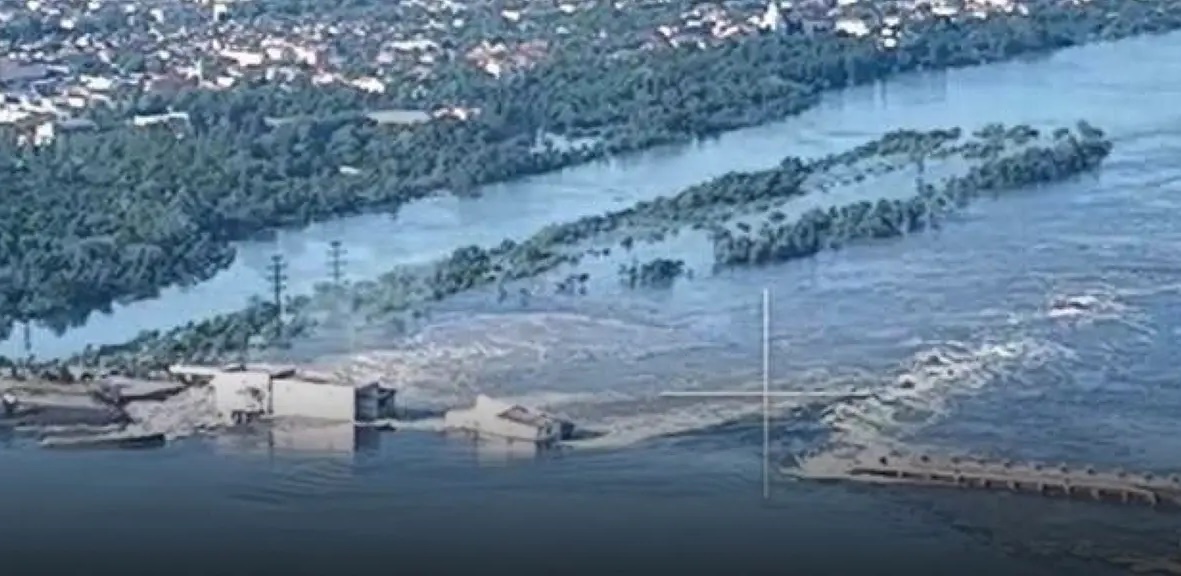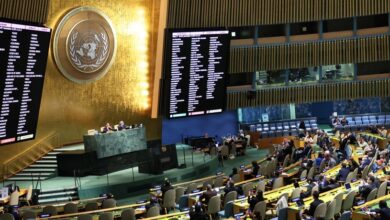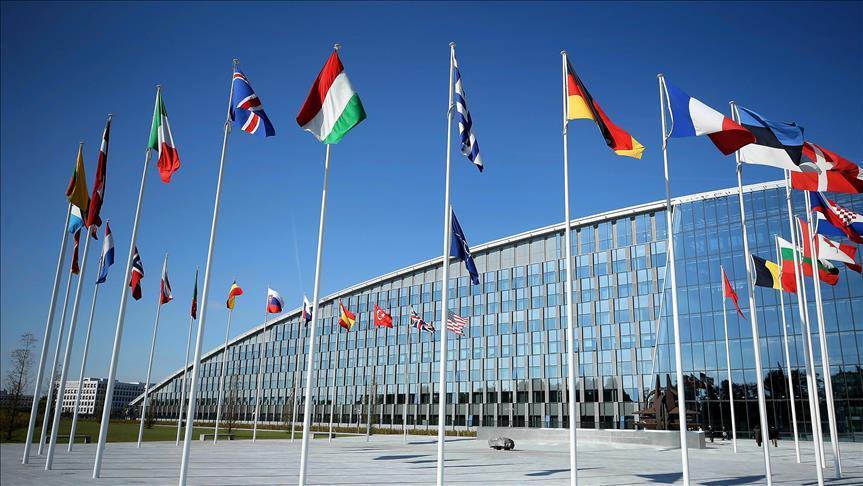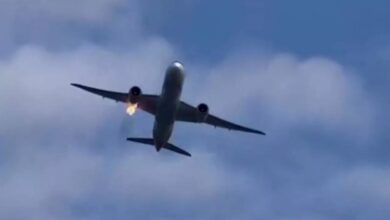Severe flooding after dam collapse
After the destruction of the Kachowka dam, there were severe floods: hundreds of houses were flooded, and a state of emergency was declared in the town of Nowa Kachowka.

Chancellor Scholz spoke of a “new dimension” to the war.
In the Cherson region, which is partly occupied by Russia, there are severe floods after the collapse of the important Kakhovka dam. The Russian occupiers declared a state of emergency in the town of Nowa Kachowka, which is located directly on the dam. The water has already risen by 12 meters, said Mayor Vladimir Leontyev, appointed by Russia, on Russian state television. “The city is flooded.”
According to Leontiev, a total of 600 houses in three towns on the Russian-occupied side of the Dnipro River were affected by the severe flooding. He acknowledged that there could also be water supply problems on the annexed Black Sea peninsula of Crimea. This is supplied with water from the Kachowka reservoir.
According to the occupation administration, three districts are to be evacuated. These are Nowa Kachowka, Golo Pristan and Oleschky, the administration announced on Telegram. Russia controls the downstream left bank of the Dnipro to the east, and Ukraine controls the right bank to the west.
16,000 people in the “critical zone”
Videos on the internet showed large masses of water pouring out of the wall. According to Ukrainian information, about 16,000 people live in the “critical zone” at the dam. Prime Minister Denys Schmyhal spoke of a risk of flooding for up to 80 towns. The destruction will lead to an environmental catastrophe.
The military governor of the region, Olexander Prokudin, warned that the water level could reach a critical level within five hours. The water masses would only flow off after about five to seven days, said the World Data Center for Geoinformatics and Sustainable Development.
The operator of the hydroelectric power plant Ukrhydroenerho announced that the plant was completely destroyed and could not be repaired. The Ukrainian military began evacuations on the right-hand side of Dnipro – where the regional capital of Kherson, which was liberated by the Ukrainians, is also located.
Mutual finger pointing
The dam had been destroyed during the night. Kiev and Moscow accused each other of being responsible for the blast. Ukraine accused Russian invading forces of having blown up the dam. Russia attributed the destruction to Ukrainian shelling. The information provided by both sides could not initially be checked independently.
Ukrainian President Volodymyr Zelenskyy blamed “Russian terrorists” for blowing up the dam. The State Department called for an emergency meeting of the UN Security Council. The “Russian terror attack” had to be discussed there. The ministry also called for further sanctions against Russia, which should particularly affect the Russian missile industry and the nuclear sector.
Ukrainian presidential adviser Mykhailo Podoliak wrote on Twitter that Russia apparently aims to create insurmountable obstacles to the planned major Ukrainian offensive. This is an attempt to delay the end of the war and a premeditated crime. Podoljak also spoke of a global environmental catastrophe. “Thousands of animals will be killed and ecosystems destroyed in the next few hours,” he said.
Russia denied the allegations and blamed Ukraine. “We officially declare that this is clearly a case of deliberate sabotage by the Ukrainian side, planned and carried out on the orders (…) of the Kiev regime,” said Kremlin spokesman Dmitry Peskov.
IAEA: No immediate danger for nuclear power plants
According to the International Atomic Energy Agency (IAEA), there is no immediate danger for the Zaporizhia nuclear power plant to the north-east. “IAEA experts at the Zaporizhia nuclear power plant are closely monitoring the situation,” the agency said. In the nuclear power plant occupied by Russia, however, measures would be taken to continue operating the cooling systems, which are normally fed with the dammed water, said IAEA boss Rafael Grossi. A spokesman for the Russian nuclear company Rosenergoatom also told the Interfax agency that the nuclear power plant on the Dnipro River was not affected.
Stoltenberg: “Outrageous act”
NATO Secretary General Jens Stoltenberg also condemned the destruction of the dam. The incident endangers thousands of civilians and causes serious environmental damage, he wrote on Twitter. “This is an outrageous act that once again demonstrates the brutality of Russia’s war in Ukraine.”
EU Council President Charles Michel was also dismayed. “Shocked by the unprecedented attack on Nowa-Kachowka Dam,” he wrote on Twitter. “The destruction of civilian infrastructure is clearly a war crime – and we will hold Russia and its proxies accountable.” He will raise the issue at the next EU summit at the end of June and propose more aid for the flooded areas.
Dam commissioned in the mid-1950s
Russia invaded neighboring Ukraine in February last year and then also occupied the Cherson region. Last fall, the Ukrainian army managed to liberate part of the region – including the regional capital of the same name, Cherson. However, towns south of the Dnipro remained under Russian control, including the dam town of Nowa Kakhovka.
The dam was commissioned in the mid-1950s. On the course of the Dnipro, it is the sixth and last barrage before the Black Sea. The system makes the flat stream navigable. It dams the water over a length of 200 kilometers between Zaporizhia and Nowa Kakhovka and holds around 18 billion cubic meters of water. Large regions in the south up to the Crimea were irrigated from the reservoir. In addition, electricity is generated with a hydroelectric power station, which, according to the operator, has an output of 334 megawatts.
What is known about the destroyed dam
After the rupture of the Kakhovka dam near Cherson, numerous flooded houses are reported. The warring parties hold each other responsible. What is known so far – and what consequences the dam break could have.
What happened?
According to both warring parties, the Kakhovka Dam on the Dnipro River near Cherson – in the Russian-occupied southern part of Ukraine, near the front – was badly damaged. The dam collapsed, destroying the adjacent hydroelectric power station. Kiev and Moscow blame each other for this.
Russian mayor Vladimir Leontyev said on Russian state television that it was “obvious” that the power plant could no longer be repaired. The Ukrainian operator of the plant spoke of complete destruction.
What are the consequences of the dam collapse?
Around 600 houses have already been flooded. According to the rescue services of the Russian news agency Tass. According to the information, the city of Nowa Kakhovka is also under water – with reference to the mayor installed by Russia. The water has already risen by twelve meters, he said on Russian state television. The city is right on the destroyed dam. The Russian occupiers declared a state of emergency for Nowa Kakhovka.
More severe flooding is feared. According to Ukrainian sources, around 16,000 people live in the “critical zone” around the plant near the town of Nowa Kakhovka.
EU Council President Charles Michel spoke of a catastrophe. “My thoughts are with all the families affected by the disaster in Ukraine,” he tweeted, announcing that he would support the affected areas. He was “shocked” and said the “destruction of civilian infrastructure” was “clearly a war crime.” “Russia and its deputies will be held accountable.”
Are other regions affected?
Mayor Leontiev, appointed by Russia, admitted that there could also be problems with the water supply on the Black Sea peninsula of Crimea, which was annexed by Russia in 2014 and lies south of Kherson. This is supplied with water from the Kachowka reservoir.
Is the Zaporizhia NPP in danger?
According to the International Atomic Energy Agency (IAEA), there was initially no immediate danger for the Zaporizhia nuclear power plant, which is also located north-east on the Dnipro River. “IAEA experts at the Zaporizhia nuclear power plant are closely monitoring the situation,” the IAEA Twitter account said. “No immediate danger at the power plant.”
The state operator Energoatom also described the situation as not critical. A drop in the water level in the reservoir, which supplies the plant with cooling water, will not affect the water level in the power plant’s cooling ponds, in which the spent fuel elements are stored, says Energoatom boss Petro Kotin.
A spokesman for the Russian nuclear company Rosenergoatom told the Interfax news agency that the power plant – which, like the Kakhovka Dam, is located on the Dnipro River – was not affected. The facility is occupied by Russian troops as a result of the Russian war of aggression against Ukraine.
What do Kiev and Moscow say about the cause?
It is believed that the dam was blown up. Ukrainian President Volodymyr Zelenskyy spoke of “terror” and convened the National Security Council. The Ukrainian military began evacuations on the right bank of the Dnipro River, where the Ukrainian-liberated regional capital, Kherson, is located.
The head of administration of the southern Ukrainian Oblast of Kherson, installed by Russia, said that he saw no need for a major evacuation. In a video distributed on Telegram, Governor Vladimir Saldo blames the Ukrainian government for the destruction of the dam. This wanted to distract from the failure of their counter-offensive in the east.
There has also been speculation that the dam may have ruptured due to poor maintenance. The information provided by both sides could not initially be verified independently.
Does the location have strategic importance?
In the war between Russia and Ukraine, the Kakhovka dam was of strategic importance from the very beginning. In the course of its attack, Russia had also occupied the Cherson region. Last fall, the Ukrainian army then managed to liberate part of the region – including the regional capital of the same name. However, towns south of the Dnipro remained under Russian control, including the dam town of Nowa Kakhovka.
The Ukrainian side repeatedly warned of a possible act of sabotage by the Russians in Nowa Kakhovka. There was concern when the occupiers announced the evacuation of the city in November. The dam was built in 1956 when Ukraine was still part of the Soviet Union.



